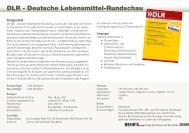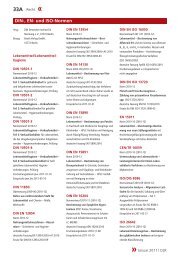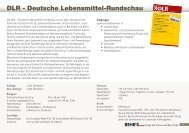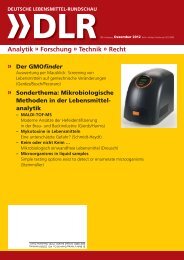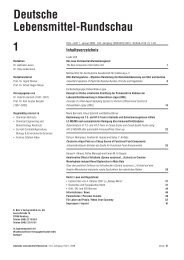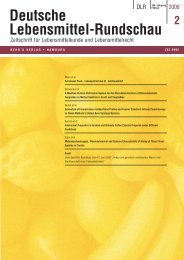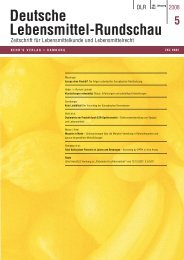Nanotechnologie in Lebensmitteln - DLR Online: Deutsche ...
Nanotechnologie in Lebensmitteln - DLR Online: Deutsche ...
Nanotechnologie in Lebensmitteln - DLR Online: Deutsche ...
Sie wollen auch ein ePaper? Erhöhen Sie die Reichweite Ihrer Titel.
YUMPU macht aus Druck-PDFs automatisch weboptimierte ePaper, die Google liebt.
Both <strong>in</strong>strumental methods used shows very similar results<br />
for Cd concentration and only <strong>in</strong> some cases the results obta<strong>in</strong>ed<br />
by FTSCP method were slightly higher <strong>in</strong> comparison<br />
to ZGFAAS method. Also, the accuracy and limit of<br />
detection were similar (0.03 μg Cd/l).<br />
Comparison of our results for Cd content determ<strong>in</strong>ed <strong>in</strong><br />
Croatian w<strong>in</strong>es with the previously published results shows<br />
the follow<strong>in</strong>g. Our value of mean Cd content <strong>in</strong> Croatian<br />
w<strong>in</strong>es of 0.02 to 0.25 μg Cd/l, are generally <strong>in</strong> agreement<br />
with results reported by: Freschi et al. 16) (average Cd<br />
concentration of 0.03 to 0.20 μg Cd/l <strong>in</strong> Brazilian red and<br />
white w<strong>in</strong>es), Kim 20) (mean Cd concentration of 0.41 μg<br />
Cd/l for white and 0.48 μg Cd/l <strong>in</strong> red w<strong>in</strong>es on the Korean<br />
market), Coetzee et al. 23) (the average concentration of 0.03<br />
to 0.78 μg Cd/l <strong>in</strong> South African red and white w<strong>in</strong>es), and<br />
Cvetković et al. 18) (cadmium content from 0.21 to 0.97 μg<br />
Cd/l <strong>in</strong> red and from 0.12 to 0.79 μg Cd/l <strong>in</strong> white<br />
Macedonian w<strong>in</strong>es). Some authors reported a slightly<br />
higher concentration of Cd, like e.g. Bra<strong>in</strong><strong>in</strong>a et al. 26) (mean<br />
Cd content between 0.11 and 1.41 μg Cd/l <strong>in</strong> w<strong>in</strong>es on<br />
Russian market), and Lara et al. 17) (mean Cd content of<br />
1.2–3.6 μg Cd/l <strong>in</strong> Argent<strong>in</strong>e w<strong>in</strong>es). However, some<br />
authors reported significantly higher Cd content (then<br />
above cited authors), like e.g. Dugo et al. 27) (they reported<br />
the mean Cd concentration <strong>in</strong> some Italian w<strong>in</strong>es from 2.0<br />
to 12.4 μg Cd/l. Such differences of Cd content <strong>in</strong> w<strong>in</strong>es,<br />
reported <strong>in</strong> papers of different authors, are normal due to<br />
different brands of grape and w<strong>in</strong>es, different conditions of<br />
grape and w<strong>in</strong>e production, different type of soil, etc.<br />
The content of Cd <strong>in</strong> w<strong>in</strong>e can be attributed (like also for Pb)<br />
to two ma<strong>in</strong>ly sources: “natural” Cd content (which come<br />
through transfer of cadmium from the soil via the roots to<br />
the grapes and f<strong>in</strong>ally to w<strong>in</strong>e) and secondary contam<strong>in</strong>ation<br />
dur<strong>in</strong>g the grape and w<strong>in</strong>emak<strong>in</strong>g process (like e.g. the use of<br />
<strong>in</strong>secticides and fungicides which conta<strong>in</strong>ed cadmium salts,<br />
due to the contact of must or w<strong>in</strong>e with the apparatus used<br />
<strong>in</strong> w<strong>in</strong>e production and packag<strong>in</strong>g process, etc.).<br />
Generally, the cadmium content <strong>in</strong> w<strong>in</strong>es has been found to<br />
be very low. However, cadmium is highly toxic element<br />
that accumulates <strong>in</strong> the human body and has a long halflife<br />
(about 30 years). Its toxicity is manifested by a variety<br />
of syndromes and diseases which <strong>in</strong>clude kidney dysfunction<br />
and damage, hypertension, hepatic <strong>in</strong>jury, reproductive<br />
toxicity, lung damage, bone effects, etc. 1,2) . Because of<br />
its high toxicity and the concern from a health safety po<strong>in</strong>t<br />
of view, many countries have set limits of the content of Cd<br />
<strong>in</strong> foods. Thus, European Commission (EC) sett<strong>in</strong>gs the<br />
maximum level for cadmium <strong>in</strong> certa<strong>in</strong> foodstuffs, but not<br />
<strong>in</strong> w<strong>in</strong>es 5) . The M<strong>in</strong>istry of Health of Republic of Croatia<br />
has established a tolerable Cd concentration <strong>in</strong> w<strong>in</strong>es of<br />
10 μg Cd/l 11) . This value is the same as the maximum<br />
acceptable level of Cd <strong>in</strong> w<strong>in</strong>e established by the Office<br />
International de la Vigne et du V<strong>in</strong> (OIV) 10) .<br />
Due to the toxicity of cadmium and the potential health<br />
risks of dietary exposure of humans to cadmium, the<br />
JECFA established PTWI value of 7 μg Cd/kg of body<br />
weight at the thirty-third Meet<strong>in</strong>g (1988), and this value<br />
<strong>DLR</strong> | November/Dezember 2008 «<br />
» Orig<strong>in</strong>alarbeiten<br />
51<br />
was ma<strong>in</strong>ta<strong>in</strong>ed at the sixty-fourth Meet<strong>in</strong>g of JECFA <strong>in</strong><br />
2005 8) .<br />
To evaluate the possible daily <strong>in</strong>take of Cd through the<br />
dr<strong>in</strong>k<strong>in</strong>g the exam<strong>in</strong>ed w<strong>in</strong>es, we used the mean Cd concentration<br />
value (0.13 μg Cd/l) of all <strong>in</strong>vestigated w<strong>in</strong>e<br />
samples. Suppos<strong>in</strong>g that an adult person consumes one<br />
glass of w<strong>in</strong>e (0.2 l) per day, on average, then average<br />
evaluated average daily Cd <strong>in</strong>take through w<strong>in</strong>e<br />
consumption would be around 0.03 μg Cd/d.<br />
The total diet studies (TDS) cited <strong>in</strong> the literature reported<br />
different total daily dietary <strong>in</strong>take (TDDI) of Cd. So, e.g.<br />
TDDI value reported for TDS <strong>in</strong> UK was 14 μg Cd/d 29) , the<br />
average daily <strong>in</strong>take of Cd <strong>in</strong> USA TDS was 13 μg Cd/d 30) ,<br />
daily dietary Cd <strong>in</strong>take by adults <strong>in</strong> Belgium is 23.1 μg Cd/<br />
d 34) , dietary <strong>in</strong>take of Cd <strong>in</strong> Germany for adults is up to<br />
27.6 μg Cd/d 35) , Cd dietary <strong>in</strong>take <strong>in</strong> TDS <strong>in</strong> Spa<strong>in</strong><br />
population was 11.17 μg Cd/d 36) , and the average <strong>in</strong>take of<br />
Cd <strong>in</strong> adults diet <strong>in</strong>vestigated <strong>in</strong> 13 European countries,<br />
accord<strong>in</strong>g recently <strong>in</strong>formation 1,2) is 14.4 μg Cd/d. Our<br />
evaluated value of 0.03 μg Cd/d from dr<strong>in</strong>k<strong>in</strong>g w<strong>in</strong>es is<br />
only 0.1–0.3 % of TDDI values for Cd reported <strong>in</strong> above<br />
TDS.<br />
In accordance with PTWI value for Cd established by<br />
JECFA 11) an adult person of 60 kg could consume daily up<br />
to 60 μg Cd/d (tolerable daily <strong>in</strong>take, TDI). Our estimated<br />
Cd <strong>in</strong>take (0.03 μg Cd/d) from dr<strong>in</strong>k<strong>in</strong>g w<strong>in</strong>es is only<br />
0.05 % of this calculated TDI. Therefore, it can be<br />
concluded that the possible daily dietary Cd <strong>in</strong>take through<br />
consumption of w<strong>in</strong>es is negligible <strong>in</strong> relation to the total<br />
dietary daily <strong>in</strong>take (TDDI) and tolerable daily <strong>in</strong>take<br />
(TDI) of Cd. Thus, Cd from w<strong>in</strong>es is negligible source of<br />
dietary Cd <strong>in</strong>take <strong>in</strong>to the human body.<br />
Copper (Cu)<br />
The results <strong>in</strong> Table 1 show that Cu content varies significantly<br />
with the brand of w<strong>in</strong>es. The mean Cu concentration<br />
of <strong>in</strong>vestigated w<strong>in</strong>es ranged from 10 μg Cu/l <strong>in</strong> white w<strong>in</strong>e<br />
Grašev<strong>in</strong>a-Kutjevo to 413 μg Cu/l determ<strong>in</strong>ed <strong>in</strong> white w<strong>in</strong>e<br />
Tram<strong>in</strong>ac. The mean concentration of all w<strong>in</strong>e samples <strong>in</strong>vestigated<br />
(78 samples) was 156 μg Cu/l. The analysis of<br />
these results shows that half of all <strong>in</strong>vestigated samples<br />
(54 %) conta<strong>in</strong>ed between 100–200 μg Cu/l. Less then<br />
100 μg Cu/l conta<strong>in</strong>ed 23 % of <strong>in</strong>vestigated samples, 15 %<br />
of samples have between 200–300 μg Cu/l, and only 8 % of<br />
w<strong>in</strong>es conta<strong>in</strong>ed more then 300 μg Cu/l (up to maximum<br />
concentration determ<strong>in</strong>ed of 413 μg Cu/l). These results<br />
show that the concentration of Cu <strong>in</strong> <strong>in</strong>vestigated Croatian<br />
w<strong>in</strong>es is significantly below the tolerable limit of Cu content<br />
<strong>in</strong> w<strong>in</strong>es established by M<strong>in</strong>istry of Health of Republic of<br />
Croatia (1000 μg Cu/l) 11) . The same maximum acceptable<br />
limit of 1000 μg Cu/l of w<strong>in</strong>e was established by OIV 10) .<br />
If we compare the results obta<strong>in</strong>ed by FTSCP electrochemical<br />
method and spectrometry FAAS method it could be<br />
seen from Table 1 that here is no significant difference <strong>in</strong><br />
the results obta<strong>in</strong>ed by these methods. Only, the limit of<br />
detection (LOD) of FTSCP method (0.3 μg Cu/l) is lower<br />
then that of FAAS (1 μg Cu/l).




